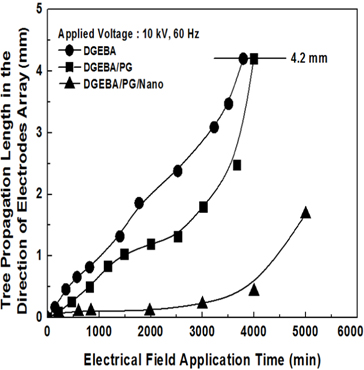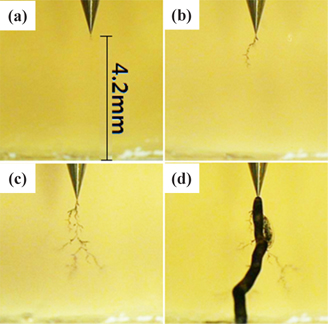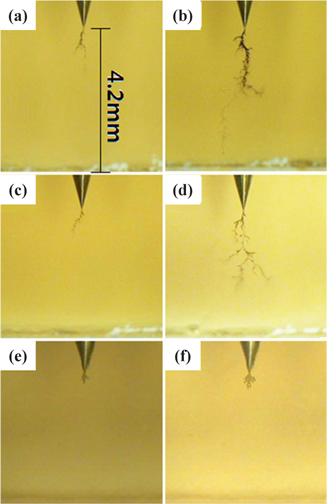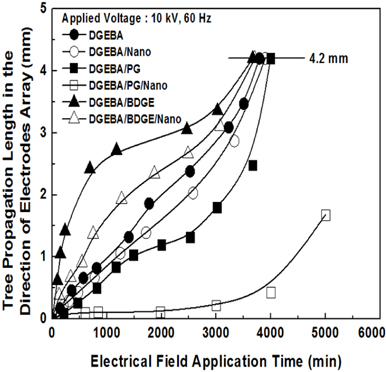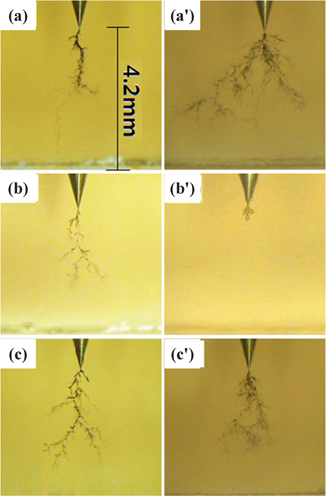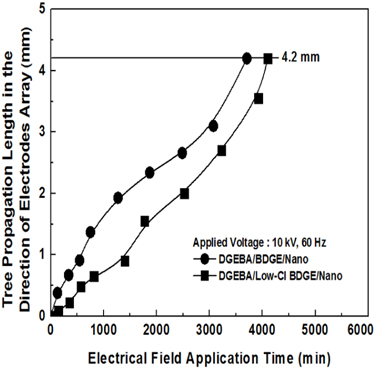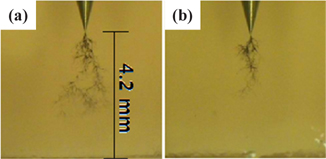



Epoxy resins have good mechanical and thermal properties, as well as excellent electrical properties, thus they have been used as insulation materials in the field of heavy electric equipment, such as mold-type transformers, current transformers (CT), potential transformers (PT), metering out-fit (MOF), gas switching gears, and so on [1-3]. In order to achieve these performances, many kinds of inorganic fillers, such as silica (SiO2) [4], alumina (Al2O3) [5], mica [6], aluminum nitride (AlN) [7], and titanium dioxide (TiO2) [8], have been incorporated into the epoxy resins.
However, when inorganic filler was incorporated into an epoxy resin, the viscosity became too high. So it was very difficult not only to disperse the fillers homogeneously and to remove bubbles from the epoxy/filler mixture, but also to inject the viscous mixture into a mold, during the curing process. Therefore, in order to decrease the viscosity, plasticizers, organic solvents or reactive diluents were introduced to the epoxy/filler composites, so that bubbles were easily removed from the composites, after injection into a mold.
However, the plasticizers disturbed the cure reaction of the epoxy system, so that the crosslink density decreased. This caused decrease of the electrical, mechanical and thermal properties of the epoxy system. Also, when organic solvent was used, it should be removed completely, after mixing epoxy, fillers and organic solvent. If not, it might act as an impurity, so that the electrical, mechanical and thermal properties of the epoxy composite would be negatively affected. Reactive diluents were used, in order to decrease the viscosity during mixing, and the electrical treeing phenomena was studied, in order to estimate the insulative characteristics of neat epoxies or their nanocomposites, because the treeing phenomena has often been referred to as the most important mechanism for the deterioration of polymeric insulators (e.g. high voltage polymeric cables) [9-12]. The treeing growth mechanism was divided into three processes: (1) incubation process, (2) initiation process, and (3) propagation process. If an electrical treeing was initiated, it would propagate rapidly, and breakdown would finally occur. Hence, the initiation time should be delayed, and the propagation rate be retarded, in order to get excellent insulation polymeric materials.
In this study, two epoxy/reactive diluent/nanosilicate systems for the insulative materials of heavy electric equipments were prepared, and the effect of reactive diluent on the electrical treeing phenomena was studied, in needle-plate electrodes.
A commercial DGEBA (diglycidyl ether of bisphenol A) type epoxy resin was used, of trade name YD 128 (Kukdo Chem. Co.). The equivalent weight was 184~190, and the viscosity was 11,500~13,500 cps at 25℃. The curing agent was Me-THPA (3-or 4-methyl-1,2,3,6-tetrahydrophthalic anhydride), whose grade name was HN-2200 (Hitachi Chem. Co.). It is widely used in the field of electric insulation. An accelerator was BDMA (benzyldimethyl amine, Kukdo Chem. Co.). A reactive diluent employed as a flexibilizer was a polyglycol (PG), under the trade name DY-040 (Ciba-Geigy Co.). Its molecular weight was about 7,000~10,000, and its viscosity was 60~90 cps at 25℃. Another reactive diluent as an aliphatic epoxy resin was purchased from Kukdo Chem. Co., under the trade name of BDGE. Its equivalent weight was 120~140, and its viscosity was 15~30 cps at 25℃. Its chlorine content was 25,000 ppm (max). Low-chlorine epoxy resin, whose chlorine content was 4,000 ppm (max), was supplied by Hajin Chemtech Co. Cloisite® 10 A (Southern Clay Products, Inc.), and was used as a layered silicate, which was organically modified with 2MBHT (dimethyl-benzyl-hydrogenated tallow quaternary ammonium), as a sort of quaternary ammonium salt. It was also dried at 110℃ for 24 h in vacuum oven, and stored in desiccator, before use. A needle-type steel electrode was purchased from Ogura Jewelry Co., Japan. Its diameter and length were 1 mm and 60 mm, respectively, with a tip angle of 30°, and a curvature radius of 5 μm.
2.2 Specimen preparation for ac treeing test
To prepare the epoxy/reactive diluent/nanosilicate systems, DGEBA (100 g)/reactive diluent (10 g) and Cloisite 10 A (2.74 g) were mixed with ultrasonic homogenizer (20 kHz) for 30 min, and then put into an ac electric field apparatus developed by us [13]. The ac electric field was generated by a high voltage (HV) generator, in the following conditions; (1) inter-electrode distance: 50 mm, (2) application voltage: 11 kV, (3) frequency: 1 kHz, and (4) application time: 60 min. During the ac application time, epoxy resin penetrated into the interlayer, making the layered silicate swollen. Then, the mixture was mixed with THPA (80 g) and BDMA (0.9 g). The weight percent of nanosilicate in the epoxy nanocomposite was 1.5 wt%.
The mixture was poured into a mold having a cavity of 15×15 mm2 with 30 mm height, in which a needle electrode was arranged beforehand, to make the distance of needle-plate electrodes be 4.2 mm. Then, it was cured at 120℃ for 2 hr, and postcured at 150℃ for 2 hr, and then cooled slowly at a rate of -0.5 ℃ /min until room temperature, to avoid internal stress. Finally, the opposite side of the needle electrode in the epoxy specimen was coated with conductive silver paste.
To measure the treeing rate at a constant alternating current (AC) of 10 kV/4.2 mm (60 Hz), the specimen with needle-plate electrode arrangement was inserted into the insulating oil at 30℃, and maintained sufficiently for 2 hr, until the temperature of the needle tip area reached oil temperature. Then, high voltage (HV) was applied, by using AC Endurance Voltage Tester (Haefely, Germany), at a rising speed of 1 kV/s until 10 kV; and the test voltage was kept, until electrical breakdown took place. The treeing morphology was monitored by a video microscope system (ICS-305B, SOMETECH Inc.), with the treeing images being collected every 1 min.
Figure 1 shows the treeing growth rate in three epoxy systems, under the constant AC electric field of 10 kV/4.2 mm (60 Hz), at 30℃. The three epoxy systems were neat DGEBA system, DGEBA system with PG as a reactive diluent, and DGEBA/PG system with nanosilicate. In the DGEBA system, the propagation rate of the electrical treeing was 1.10×10-3 mm/min, and breakdown finally took place in 3,794 min. In the DGEBA/PG system, the treeing propagation rate was 1.05×10-3 mm/min, which was 1.05 times slower, and the breakdown time was 3,996 min, which was 1.05 times lower than that of the DGEBA system. These results meant that there was almost no effect of PG on the tree propagation rate. As 1.5 wt% of nanosilicate was added to the DGEGA/PG system, the propagation rate was 0.33×10-3 mm/min, which was 3.2 times slower than that of the DGEBA/PG system. This meant that the nano-sized layered silicates were well dispersed in the epoxy matrix, and that they would act as good barriers to treeing propagation [14].
The morphology of electrical treeing for the DGEBA/PG system is shown in Figure 2. The typical behavior of branch type electrical treeing was obtained from the morphology observation. That is to say, when a constant AC electric field of 10 kV/4.2 mm (60 Hz) was applied, electrons were injected and extracted at the needle tip, so that small electrical treeing was faintly initiated from the needle tip (Fig. 2 (a)). Then, electrons injected and extracted at the newly generated conductive treeing tip- which had been carbonized, so that several branches were newly appeared, and they grew rapidly, became fatter and darker, with many new branches (Figs. 2 (b) and 2 (c)), and finally, the penetration breakdown took place, from the needle tip to silver electrode plate (Fig. 2 (d)).
Electrical treeing phenomena for DGEBA and DGEBA/PG/ nanosilicate systems were compared to those of the DGEBA/ PG system, as shown in Fig. 3. Fewer branches were shown in the DGEBA system than those of the DGEBA/PG system, as displayed in Fig. 3(b). In a similar time of the propagation state, the primary branches formed with few new secondary branches. That is to say, electrons that were injected and extracted at the needle tip generated small electrical treeing from the needle tip in the initial stage, and then electrons were injected and extracted at the newly generated primary treeing tip, which had been carbonized. Because there were no barriers in the DGEBA system, the treeing grew straight from the needle electrode to the plate electrode. However, the treeing shape was bush type, and the length grew very slowly, as shown in Figs. 3 (e) and 3 (f ). The treeing became fatter and darker, without any new branches. These results meant that the treeing growth was disturbed by the dispersed silicate monolayers. The bush type tree might be because the momentum power of the injected electrons couldn't pass through the silicate monolayers, so they should develop a new root, to avoid the silicate monolayers. It was a time-consuming process. Therefore, it was found that well-dispersed silicate monolayers acted as good barriers to the treeing propagation.
Figure 4 shows treeing growth rates for the DGEBA, DGEBA/ PG and DGEBA/BDGE systems, and those for the three nanosilicate nanocomposites are also compared in the same figure. In the DGEBA/PG/nanosilicate system, it was found that the treeing growth was disturbed by the dispersed silicate monolayers, as was previously explained. The barrier effect of the nanosilicate layers in the other two systems was also found. In the DGEBA system, the propagation rate of the electrical treeing was 1.10×10-3 mm/min, while that in the DGEBA/ nanosilicate system was 1.07×10-3 mm/min, which was 1.03 times slower. In the DGEBA/ BDGE system, the propagation rate of the electrical treeing was 1.15×10-3 mm/min, while that in the DGEBA/BDGE/nanosilicate system was 1.13×10-3 mm/min, which was 1.02 times slower. The barrier effect of the nanosilicate layers in DGEBA and DGEBA/ BDGE systems was very low, compared to 3.2 times in the DGEBA/ PG system. These results indicated that a synergetic effect of PG and nanosilicate layers was found.
The treeing morphologies for each epoxy system and its nanosilicate system are compared in Fig. 5. A shorter treeing propagation was displayed in the DGEBA/PG system, and far shorter treeing propagation was shown in the DGEBA/PG/nanosilicate system, this meant that PG could slightly retard the treeing propagation rate, and a synergetic effect of the PG and nanosilicate layers was found. Therefore, PG could be used as a reactive diluent in the DGEBA system, withoutdeterioration of the insulation breakdown property. However, BDGE could not be used as a reactive diluent, because it gave some degradation effect to the insulation breakdown property. Figure 6 shows the effect of chlorine content in the DGEBA/BDGE/ nanosilicate system on the treeing growth rate, tested in the constant electric field of 10 kV/4.2 mm (60 Hz), at 30℃, and the electrical treeing morphologies are shown in Fig. 7. The treeing growth rate for DGEBA/BDGE systems with low-level chlorine was 1.10 times slower than that of the system with high-level chlorine. The branch type treeing morphology showed a bad effect of the chlorine element. This may have been due to the easy reaction between the epoxide group and chlorine atom, so that a loose crosslink network was formed [14].
The effects of reactive diluents on the AC electrical treeing in epoxy/nanosilicate systems were studied, by carrying out a treeing test, at constant alternating currents (AC) of 10 kV/4.2 mm (60 Hz), in needle-plate electrode geometry. In the DGEBA system, the propagation rate was 1.10×10-3 mm/min, and that in the DGEBA/PG system was 1.05×10-3 mm/min. As 1.5 wt% of nanosilicate was added to the DGEGA/PG system, the propagation rate was 0.33×10-3 mm/min. This meant that the nano-sized layered silicates would act as good barriers to treeing propagation, and a synergetic effect of PG and nano-sized layered silicate was found. The effect of chlorine content was also studied, and it was found that chlorine had bad effect on the electrical insulation property of the epoxy system.
